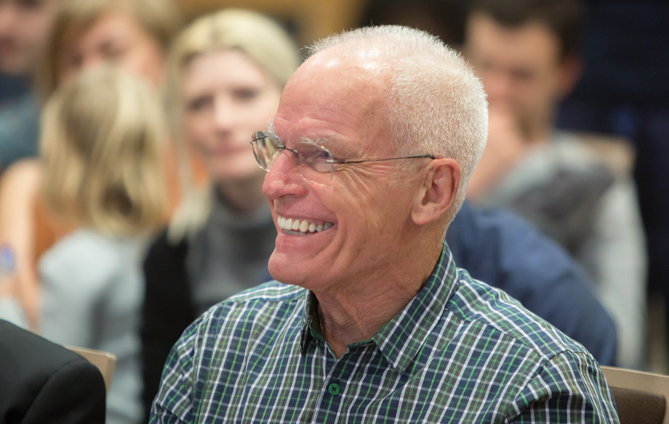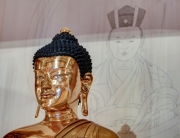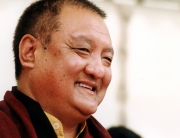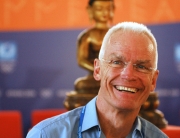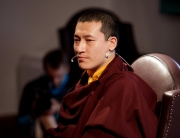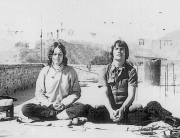by Lama Ole Nydahl
After being inspired, many feel strong gratitude and experience different physical signs such as a quickened heartbeat and warmth. These signs strengthen their feeling that something meaningful was activated within them.
Not so many recognize the following process at once, but Hannah’s and my experience of transmission is that habitual limitations gradually disappear and that the openness created naturally leads to maturity. Of course we had the great privilege of being with the 16th Karmapa, the greatest of yogis. He, the other great lamas of our “red-hat” Kagyu lineage, and today our 17th Karmapa Trinley Thaye Dorje are truly inspiring examples and their insights easily reach people. It is their transmission, unbroken since the Buddha’s days, which we all pass on today. If one can open up to it, the direct experience received will grow and deepen, over the rest of one’s lives till enlightenment. It also goes beyond anything personal. In 1981 when the 16th Karmapa died, it was like being thrown into ice water. It made everything that we had learned even more precious, and we see that he is still with us today. What stayed and grew is the awareness that now we must work harder! This awareness increased when the passing of time took away more of our realized teachers, like Lopon Tsechu Rinpoche, who will never be forgotten.
Today, Shamar Rinpoche, Sherab Gyaltsen Rinpoche and above all the 17th Karmapa, Thaye Dorje, shine on our work. It is a joy to see Karmapa grow and embrace the world. Though self-effacing whenever possible and totally without pride, he tells us that once he is the same age as the 16th Karmapa was when Hannah and I met him, he will have many of the same qualities as his previous incarnation did. This will be deeply welcomed, since confused future generations will need him more than ever.
Because of such teachers I see transmission as something total, which triggers some deep insights in one’s subconscious; a deep confidence or experiences from a former life are awakened. Hannah and I had no doubt that insights and real energies were passed on to us, and I have that same experience myself when giving blessings in their name.
Historical perspective
Three lineages in Tibetan Buddhism—the “unreformed”, “red hat” schools—describe themselves as Diamond Way, Dorje Tegkpa, or Vajrayana. These are the Nyingma, Sakya, and Kagyu transmissions.
The Nyingma arrived with Guru Rinpoche around year 750 and was crushed by the king Langdarma, a shamanist, around year 800. Left from this first flowering of the teachings were Guru Rinpoche’s termas or hidden treasures, which have been discovered over many centuries. For our work today, his amazing prophecy from 1,250 years ago does not cease to amaze: “When the fire ox runs on wheels, the iron bird flies everywhere and Tibetans are spread like ants around the world, my teachings will come to the land of the red man.” (To Tibetans, European complexions are seen as red.) That is what is happening in our time. Already then he foresaw the airplanes, the old-style locomotives and the later flight of his countrymen from Mao Tse-tung’s armies. The accuracy is impressive. The Nyingma texts are often very ritualistic and work with the transformation of anger and pride.
The story of the cultural hero Marpa is more psychological and easier to identify with. It focuses especially on transforming attachment. Around year 1050 he crossed the Himalayas three times to study in India. Staying almost seventeen years in that culture, he collected what came to be called the “new” Diamond Way teachings. It was during the centuries when Muslim armies—following their holy God—were destroying the high spiritual culture of northern India and the yogis wanted their teachings to survive. At that time practitioners only received one initiation and were expected to practice it throughout one’s life; Marpa however was able to obtain a vast amount of teachings that utilize mind’s awareness, mind’s energy, and mind’s ability to identify with its perfect nature, the so-called Guru Yoga.
In the prevailing atmosphere of impermanence, it is stated that Marpa could learn from 108 gurus and later introduced their teachings into Tibet. Most important were his two outstanding lamas: Naropa, who gave him the six teachings on inner energies and the experience of the Great Seal, and Maitripa, who gave him the logical structure of the four states of the Great Seal.
Marpa brought this richness to Tibet when he revived Buddhism there around year 1050. So if we are lay practitioners today, we are actually Marpa-Kagyu. Our monks are Dhagpo Kagyu, because they follow Milarepa’s student Gampopa—the so-called Dhagpo Lajhe (Doctor from Dhagpo)—who was the first Kagyu monk. Marpa however is our root, with his beer, his ladies, and his fearlessness. A powerhouse of a man, a great yogi, and a mountain of joy.
After Marpa came Milarepa, the ultimate ascetic. He received Marpa’s transmission through his devotion. Practicing in caves day and night, he actually became enlightened because of his fear of dying with 35 family enemies on his conscience, whom he had killed at his mother’s insistence. It is obviously an unusual event, but that is what all sources say. Milarepa had two main students. One was Rechungpa, who continued the yogi tradition and had great compassion on lonely ladies. In the meditation on the 2nd Karmapa he is seated in his human form under Guru Rinpoche and behind Karma Pakshi—which is an unusual honor. The other student of Milarepa’s was Gampopa, who is mentioned above. He was the first monk in our lineage and established that side of our work. A realized meditator himself, he organized things, making sure that the accumulated knowledge of the lineage would be preserved and protected.
During this flow of methods, wisdom, and experience from India to Tibet, the feeling of openness, trust and devoted thankfulness remained intact—as is evident from the life-stories of the “golden mala” of our lamas. Today, an unbroken line of fine teachers led by the 17th Karmapa Thaye Dorje and the 14th Shamar Rinpoche secure a Diamond Way Buddhist transmission with the absolute minimum of politics needed for its protection. Known as the “oral transmission,” it reaches fine and free minds worldwide. Also the Nyingma and Sakya traditions use this term, while the state church, the Gelugpa “virtuous” yellow-hat lineage, which arose 400 years later around 1450, prefers the term “Great Way.” This mirrors their teaching and practice, which stresses celibacy, debate, and logical thinking over transformative meditation experiences, at least for the vast majority of their adherents. They study in monastic schools and continue their training from the vast monasteries of Tibet. First they learn the principles of compassion, wisdom and strength and later recognize their teachers as expressions of these liberating and enlightening qualities. The three old red-hat schools developed many convincing yogis who readily dissolved people’s concepts. On this basis, it becomes natural to feel the teacher as the main focus and the buddha-qualities as their expression. So for us Guru-Yoga becomes the main practice and the Buddha forms are then the many aspects of one’s teacher.
This kind of empathy and openness is the lifeblood especially of the Kagyu lineage, where the lives of many past—and several present—teachers are certainly not boring. From Naropa in India, who was de-intellectualized and authenticated through 12 major and 24 minor catastrophes at the hands of his teacher Tilopa. From Marpa fighting his way over the Himalayas three times and from Milarepa in Tibet building seven houses in symbolic forms only to have to tear them down again, to the adventures and excitement of today’s idealists in our Diamond Way centers, the experience of those going beyond their limits is certainty and joy.
The 16th Karmapa
Amazing developments on the absolute level of realization in spiritually free countries today are to a large extent the result of the work of the great 16th Karmapa Rangjung Rigpe Dorje (1924–1981). He was a phenomenon that the world may not see again for a long time. He manifested enlightenment as real and convincing in all its aspects. Increasing year by year, modern communications are bringing that gift to ever more hopeful people worldwide.
For work in the West, this Karmapa chose Hannah and me, and this work continues for Trinley Thaye Dorje, his present incarnation. He could certainly have found better people, but maybe not with the same experience and devotion. When giving us formal refuge in September 1970 in Sikkim he said, “Now you have to think of me as the Buddha.” Blissed out by his closeness, I answered, “You are better than any Buddha. You are better than anything.”
When we met him first on December 22, 1969, in Kathmandu, he placed his hands on our heads. As we looked up, he became bigger than the whole room and filled it with immense golden light. That was how we first received his transmission. As described in my books Entering the Diamond Way and Riding the Tiger1 and other sources describing our twelve years as his close students, such events continued without pause and on ever deeper levels, adding to our already exciting lives the dimension of magic that actually works.1 Both books are from Blue Dolphin Publishing.
Differences in geography
One used to say that American and British cultures, where privacy is so highly valued, bring a natural inclination towards the Theravada, “the words of the elders of the order.” Romanic Europe, France and the countries south of the Alps, preferring vast concepts while still valuing a distance which gives one a choice, embraced the deep philosophy of the Mahayana or “Great Way” while the Germanic-Slav countries from the Rhine to Vladivostok seek shared experience and togetherness and are therefore disposed towards the intense and transforming Diamond Way. However, with the common education given in most countries today in order to remain competitive, such differences are melting away and with some effort people everywhere find Buddhist teaching more attuned to their qualities than to their cultures.
Here, in breathtakingly beautiful and always-new North America, Diamond Way centers today establish themselves across the country on the basis of friendship and shared idealism. Especially the Heartland and other areas with quality education and strong historical central European roots seem to have an easy and natural access, with activity ranging all the way to Maui.
After heavy scandals in the eighties, mainly due to a vast organization lacking accountability, today a healthy willingness to laugh at and criticize strange and dangerous kinds of spirituality has matured many fine minds and we stand on strong foundations in the United States and Canada as well as in a growing network of centers in the Hispanic world.
Benefit in Today’s World
The benefit is amazing. Being stimulated inwardly on the basis of trustworthy values like mind’s indestructible essence, joyful play, and tendency towards compassionate activity brings the wonderful state called inner retreat. One needs less energy for—and even enjoys—challenges and work if one’s center is stable and situations are experienced as meaningful teachings on how to benefit others. Drawing back from foolish or mind-numbing activities and using one’s time for something worthwhile, suddenly one feels rich and will naturally attract similarly enjoyable people. When “emerging” from this state, there is happiness but its direction has changed. Others do short-term things for themselves while we seek character-building situations for everyone. Above all, one is automatically triggered if one’s influence appears to make them identify with aspects of their buddha nature.
Finally one does both, is aware and effective at the same time and at that stage experience, motivation and view developed over countless lives give automatic direction. Some pacify, while others increase the given potential. Others fascinate and protect.
Being Danish, I see it as my special function as a lama to always make sure that my students don’t feel stupid or embarrassed but rather solid and on the cutting edge of any critical encounter. In the Himalayas, as long as people have money they may walk around like zombies and few but those targeting them will notice. In the West however, everybody is noticed and judged by their level of functioning. Here the practitioner has to be cool, clear and still not lose one’s inner warmth of devotion at the same time. It is more difficult in a demanding society to still be “in” the world (functioning) but not “of” the world (tied to it), as they said in the Middle Ages. The ability to function while not being trapped by events or losing people’s confidence by being dependent, impractical or exotic is best learned in short, focused retreats with exciting activity in between. I think that here we are doing very well; teaching my students the “stiff upper lip” is very much my thing. Danish humor is made for that.
On their search for values, practical people often ask: He is a Buddhist, so how is he handling life? Is he with it? Is he functioning? Or how are Buddhists generally behaving worldwide? Here it is important that we function while also staying informed, taking a fearless stand for our freedoms and other core values while evidently developing as human beings. When competition becomes secondary, and mainly for fun and we begin to say: “Isn’t it fantastic… We have such skillful people,” then something has been learned.
This is how transmission works, both inwardly as well as in our actions, and it must not be blind. It should be nourished by information on essential subjects such as the birth rates in different cultures and a willingness to find solutions that place quality above quantity for the future world.
Also if one is practicing Tibetan Buddhism one should decide to stay with one lineage and not guru-hop. The transmissions are different; different terms are used for similar things and vice versa and mixing them is a certain road to confusion. Also, don’t give up unless really dissatisfied with what you have; it is the job of every teacher to diminish the students’ egos and this may be unpleasant but is absolutely necessary. However, if the lama has experience and compassion, one can make this a conscious and interesting process. That is why I am so very glad we Diamond Way Karma Kagyus naturally build on friendships and work in groups, because this holds us together while we practice the same timeless methods given by our Karmapas.
Our future?
When I look ahead, I see you worldwide as fit to carry on our energy and work. In spite of good Viking genes, I will be not in this body forever. Therefore you have to be there and learn, starting now. Every one of us is Buddha’s ambassador. Every one of us will be the first Buddhist that somebody else meets. Through the impression you give, you may therefore be the most important person that somebody meets. However, if they have questions or look for an example, your devotion will be not enough. Ultimately our closeness, transmission and trust are the horseshoes in our boxing gloves against ego, but it is our ability to explain human experience, our steadfastness and care for others that attract. We must know that the Buddha lived and taught in India 2450 years ago, that there were three Buddhas before him and that hundreds will follow. That he taught the levels of causality, motivation and view, giving information to be questioned rather than just believed, meditations to incorporate in our lives and advice not to lose the acquired level again. We should represent whatever was found to be valuable for our lives and secure it with fitting advice. To this skeleton you may then add the muscles and organs attractive to you or answer questions, your living bond to the listeners. So let them ask as soon as they feel comfortable, and keep referring to the main structure just mentioned so they have A-ha experiences and lose their confusion at meeting—probably for the first time—beyond-dualistic insights. Therefore please trust yourselves. Share with friends, as they are a great benefit.
Actually, representing Diamond Way Buddhism brings much freedom and joy. It is a pleasant subject to represent, because happiness beyond duality is perfect. Nothing must be taught with moralistic pointing fingers. Instead all is raw material to be used intelligently for beings’ development. It is also without end. If presenting the level of causality, which is today taken care of by countless rules, regulations and laws, one always has to warn against this or that. And if speaking from the level of motivation and the Great Way, one must watch out against long-windedness and sentimentality or becoming stiff or bureaucratic… anyway, the Christians do the second part much better than we.
In the few cases where a teacher was authorized by her or his lama to teach the Diamond Way—because sufficient joy, solidity, maturity and life-experience was developed, allowing one to represent Buddha’s ultimate teaching in a way which even the most sour person cannot mistake for nihilism—it becomes a question of visibly embodying this awareness while introducing people to the joy of their buddha nature.
Today, historically, we have a new and explosive situation. During 2500 years, this highest level of Buddhism was passed on in insular cultures and through traditional, restricted and highly structured lineages. Our time of general high education is the first time when machines fly in the sky and a Bill Gates or Steve Jobs can go to a garage and discover completely new methods of communicataions. Today’s society is not static or bound by expected limitations—except, of course, for our precious human values and freedoms that are upheld in the constitutions of free countries.
I always carry a palm-sized copy of the American Constitution, leather bound with golden edges. That is because I think it is a beautiful document. “We the people…” Everybody should have the freedom to choose and generally enjoy all the freedoms, which don’t hurt others. In Europe, we say, “My tolerance ends where your intolerance begins” which is—historically with Communism, Nazism and today Islam—more fitting to our situation.
But back to our job of representing Buddha in a clean and inspiring way: Working as his ambassador brings many blessings. But you yourselves have to give the lectures. It is your responsibility to set the teachings in a mature and comprehensive frame, which mirrors your own understanding and growth, keeping in mind that a teacher who is still learning is better than none.
Then, opening up to the lineage, you will feel guided and know that the Buddhas want you to do well. They do guide us; they do bring us into situations where we will grow. Also in your private lives, you will see that when you have gone through a difficult situation yourself, people will come to you who need on their own way exactly the information and wisdom that you have gleaned. The Buddhist solution you will have explored is what will also help them. That is an immense joy and then you will think, “Use me more, give me any situation I can learn from.” This is meaningful.
It is truly a vast energy and awareness, which then manifest ever more frequently. It understands events, begins to grow and to use our capacities from the moment we remember our refuge. Working through things and maturing in the inner retreat of our newfound but timeless values, and passing them on, makes us find both certainty and all kinds of potential and qualities. That is our transmission, looking in the mirror and seeing what is aware. We all have to give what we can to an unnecessarily confused world, which is actually a Pure Land.
Please remember that your group, the sangha, is a steady teacher and mirror to everybody’s development. That is the blessing of working in idealistic groups, sharing one’s values. We should thank one another for that function. When we are together in clean and constructive situations, the wisdom and experience of the lineage appear. In a group of meditating friends having the same refuge, everybody will then put in those pieces from their subconscious, which make a given situation function. It always works like that.
Connecting to the lineage and the transmission that accompanies it is beyond the personal and transcends the individual lama. You will see that when Gyalwa Karmapa comes to North America, or if Shamar Rinpoche or Sherab Gyaltsen Rinpoche visits. They express the same blessing field in different ways. At the same time, each lama attracts different kinds of students. All Kagyu teachers also share the common bond of helping others, the most important of motivations. On such levels, everybody does what they can. In the end, transmission is living experience. It becomes activity when view and understanding move it from the head to the heart. In the beginning it is wise and necessary to follow specific advice, do things in certain ritual ways. Later, when this has been accomplished, one will teach and inspire others fluently and at the same time faultlessly pass on what was learned.
Prodded on by one’s Bodhisattva Promise, the understanding of the emptiness of all phenomena of a lasting own-nature, and by one’s wish to benefit all beings, one cannot really go wrong. In our groups and centers, our protection is our sense of humor, which lets us rise above things, and our power and endurance come from our friendship. That gives us our strength.


